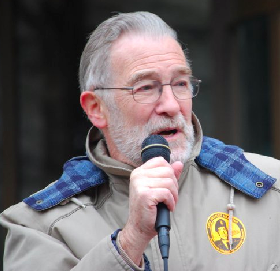This piece was reprinted by OpEd News with permission or license. It may not be reproduced in any form without permission or license from the source.
Thus, THINTHREAD was developed precisely to unite data associated with terrorists/criminals from all databases. An analyst was able to do one simple query on participants on a targeted activity and get access to all related content -- be it from computer, phone, or pager.
Now, Mr. President, perhaps you have been in Washington long enough not to be surprised by what happened next to THINTHREAD. Most of us have been around a lot longer than you, but even we found it shocking -- and, as we will show below, ultimately devastating in its implications.
In short, since THINTHREAD was developed in-house at NSA, it cost about $3 million to build and to make operational at three sites. Members of Congress, however, had political incentive (the imperative to appear to be doing something against terrorism) and financial interest (no need to spell that out) in throwing billions at NSA.
In the end, NSA Director Michael Hayden rejected THINTHREAD in favor of a contractor program called TRAILBLAZER, upon which billions of dollars were ultimately squandered and which never became operational. NSA SIGINT (signals intelligence) Director Maureen Baginski announced the Requiem for THINTHRAD to William Binney and Edward Loomis in a private meeting on August 20, 2001, three weeks before 9/11.
Some Programs Don't Cost Enough
This is how it went down: In 2000, as THINTHREAD was beginning to show promise, the head of the NSA Transformation Office (NTO) asked the creators of THINTHREAD (Loomis, Binney, and Wiebe) what they could do with $1.2 billion. We told him that, with that amount of funding, we could upgrade every one of our field installations that had access to foreign Internet sources, as well as upgrade collection equipment to access greater bandwidths available on fiber. But for the equipment, maintenance, and other costs for THINTHREAD, we only needed about $300 million.
Director Hayden reacted swiftly on learning of this. He removed the NTO chief, replacing him with a senior vice president of Science Applications International Corporation (SAIC), which became one of the leading contractors for a replacement project called TRAILBLAZER. TRAILBLAZER was originally budgeted for $3.8 billion, but after burning away most of that money, it had to be jettisoned in 2006.
No functioning components had been produced, much less delivered; Gen. Hayden had been forced to confess to the Senate Intelligence Committee that TRAILBLAZER was vastly over budget as well as well behind schedule. And our (Binney/Loomis/Wiebe) complaint to the Department of Defense Inspector General had generated a highly critical report on TRAILBLAZER, which was also a factor in its termination. SAIC, though, continued to serve as one of NSA's major prime development contractors and remains so to this day.
Hayden had announced TRAILBLAZER to great fanfare in the spring of 2000, as he began to show more preference for opening the door wider to the private sector. A year before, NSA's New Enterprise Team, which included some of the undersigned, had begun to learn of contractor complaints over getting only maintenance contracts, while the most interesting work was being conducted in-house.
That fall, an NSA Red Team predicted that TRAILBLAZER would fail unless major changes were made to the program. Hayden, however, ignored the Red Team report, and none of the Red Team recommendations saw the light of day.
This particularly unconscionable (Hayden-SAIC-Congress) corruption is a case study in how the drive for big money and the power can squander big taxpayer bucks, chip away at our constitutional protections -- and, more important, as we shall explain below -- play a crucial role in the worst intelligence failure since Pearl Harbor -- 9/11.
You will hear the usual denials. With all due respect, we think caution is indicated in thinking about taking them at face value. We would encourage you to get ahead of the curve this time.
The financial fiasco could not be kept from Congress or the Pentagon. Recognizing NSA's inability to manage multi-billion dollar programs, NSA's "Milestone Decision Authority" -- that is, the responsibility for planning, acquiring, and implementing major intelligence capabilities was revoked and responsibility was transferred to the Under Secretary for Acquisition, Technology, and Logistics at the Department of Defense.
After 9/11, Most of Us Out
The financial and managerial corruption was bad enough. To our horror, after 9/11 we came to realize that the abuses occurring during the years before 2001 had gravely damaged NSA's capability to thwart attacks like 9/11. Wiebe, Binney, and Loomis retired. Thomas Drake (also undersigned), who joined NSA on August 26, 2001, as a senior executive after many years as an NSA contractor, stayed on in an attempt to right the ship.
All of us very soon learned that we didn't know the half of it -- that is, of the misfeasance and malfeasance leading directly to NSA's substantial contribution to the intelligence failure that day.
Next Page 1 | 2 | 3 | 4 | 5 | 6 | 7
(Note: You can view every article as one long page if you sign up as an Advocate Member, or higher).





